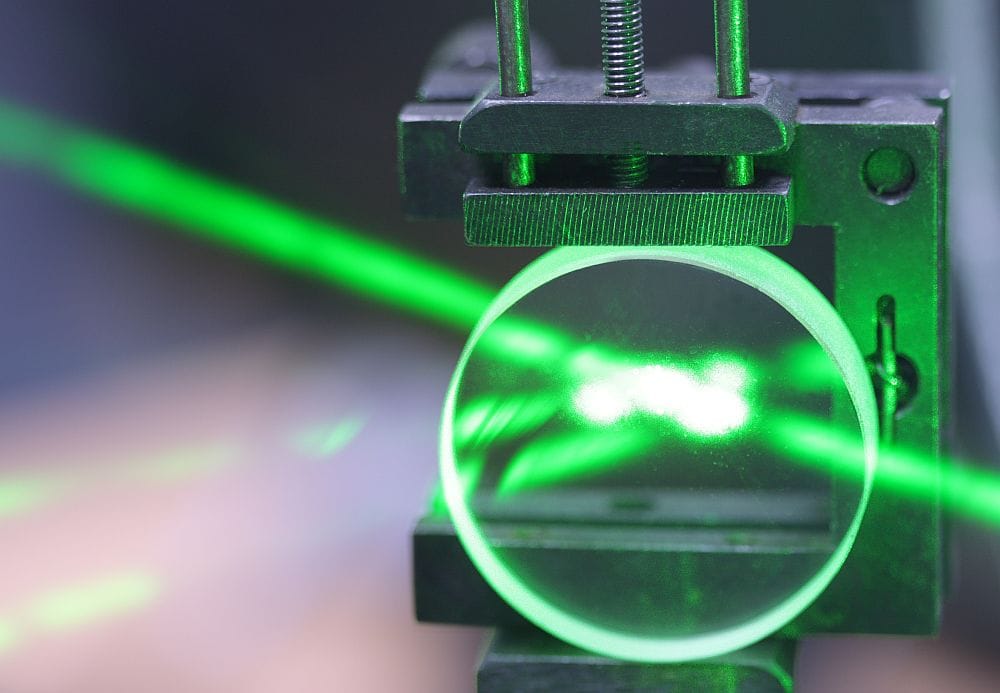
[Image above] A sample of epsilon-phase tungsten trioxide before (left) and after (right) an electric current is passed through it. Because of the ferroelectric nature of this material, it opens the possibility of creating single-layer smart windows. Credit: Pelagia-Irene Gouma
As the days stretch longer with the coming of summer, it can be difficult to appreciate just how transformative this yearly cycle was for people living prior to the 19th century. Before then, people’s daily activities largely ceased with the setting of the sun. But after the invention of gas lighting and later electric lighting, people no longer relied on the sun for illumination—which fundamentally changed our relationship with light.
Our ability to control light and use it for purposes beyond general lighting advanced rapidly over the past century. We can now transmit information over dozens of miles via light waves guided down highly engineered optical fibers and display a wider color range on screen through cutting-edge organic light-emitting diode technology.
One limitation of many current optical technologies is their size. Optical instruments such as microscopes, telescopes, and cameras typically require multiple mirrors and lenses to accurately guide light, which makes the devices bulkier and hinders their use in space-constrained applications, such as satellites and hospital operating rooms.
Optical devices that can precisely regulate the direction and intensity of light using fewer layers open the door to employing optical instruments more efficiently and in a wider variety of settings. In a recent paper, researchers at The Ohio State University led by ACerS Fellow Pelagia-Irene Gouma described an advancement in simplifying one increasingly relevant optical device—electrochromic smart windows.
Exploring ε-WO3 for next-generation electrochromic devices
Smart windows improve the energy efficiency of buildings by regulating the amount of light entering the building. They work via a phenomenon called electrochromism, which is when a material displays changes in color or opacity in response to an electrical stimulus.
Tungsten trioxide (WO3) is the most common electrochromic material used in smart windows to regulate the transmission of light. Specifically, its gamma (γ) phase and hexagonal crystal structures are well known to exhibit traditional electrochromic behavior.
To trigger the color change in WO3, ions must be inserted into the WO3 structure. Smart windows typically achieve this feat via a five-layer assembly consisting of a transparent electrode, a layer of WO3, an electrolyte, an ion storage layer, and another transparent electrode.
Researchers have attempted to develop simpler electrochromic devices with fewer layers using complex gel mixes, but these devices face challenges with lifetime, stability, and ease of manufacturing. In the new study led by Gouma, however, these challenges are overcome by adopting the lesser known epsilon (ε) phase of WO3, which demonstrates a unique type of electrochromism.
ε-WO3 is an acentric, monoclinic polymorph of WO3 that conventionally is only stable at -45°C. Based on its structure, researchers believed ε-WO3 may be ferroelectric, meaning it exhibits a spontaneous electric polarization. However, experimental confirmation of this hypothesis was lacking, in part because no one had successfully stabilized the polymorph at room temperature for testing.
Gouma and her team recently fabricated a nanostructured powder sample of ε-WO3 that proved stable at room temperature. They then began testing its potential use in selective gas sensing, which is a focus of Gouma’s. During this testing, the material’s unique electrochromic behavior was revealed.
“We applied a voltage one day and noticed a color change that was reversible upon the switching of the voltage,” Gouma explains in an email. “This [color change] was obviously an effect that had to do with dipole alignment, and we confirmed in this paper that it is a new form of chromism (ferrochromism).”
Essentially, ferrochromism means ε-WO3 can experience color-change without assistance from an ion storage layer or electrolyte. This feat is accomplished because ε-WO3 is ferroelectric in nature, which previously was just hypothesized.
Gouma and her team developed and tested a single-layer smart window based on ε-WO3 that successfully changed color in response to electrical stimulus, which indirectly confirmed the material’s ferroelectric nature. They then experimentally confirmed the ferroelectricity through tests at the Air Force Research Laboratory, as reported in the recent paper.
While further investigations are needed to understand the performance limits of ε-WO3, these early results show that “developing the next generation of ECDs [electrochromic devices] is possible using this ferroelectric polymorph of WO3,” they write.
The paper, published in ACS Applied Optical Materials, is “Chromism in ferroelectric ε-WO3: Single-layer solid-state color-changing devices and displays” (DOI: 10.1021/acsaom.4c00021).
Author
Lisa McDonald
CTT Categories
- Basic Science
- Material Innovations


